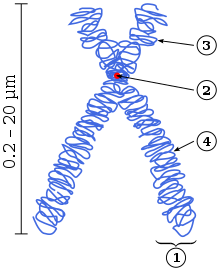Locus (genetics): Difference between revisions
→External links: {{Wikidata property |P4196 }} |
|||
| Line 1: | Line 1: | ||
[[Image:Chromosome.svg|thumb|Chromosome components:<br><BR>(1) [[Chromatid]]<BR>(2) [[Centromere]]<BR>(3) Short (p) arm<BR>(4) Long (q) arm]] |
[[Image:Chromosome.svg|thumb|Chromosome components:<br><BR>(1) [[Chromatid]]<BR>(2) [[Centromere]]<BR>(3) Short (p) arm<BR>(4) Long (q) arm]] |
||
A '''locus''' (plural '''loci''') in [[genetics]] is a fixed position on a [[chromosome]], like the position of a [[gene]] or a marker ([[genetic marker]]).<ref>{{cite journal|doi=10.1016/0307-4412(95)90659-2|title=The encyclopedia of molecular biology|journal=Biochemical .Education|volume=23|issue=2|pages=1165|year=1995|last1=Wood|first1=E.J.}}</ref> Each chromosome carries many genes; human's estimated '[[haploid]]' [[Human genome#Coding sequences (protein-coding genes)|protein coding genes]] are 19, |
A '''locus''' (plural '''loci''') in [[genetics]] is a fixed position on a [[chromosome]], like the position of a [[gene]] or a marker ([[genetic marker]]).<ref>{{cite journal|doi=10.1016/0307-4412(95)90659-2|title=The encyclopedia of molecular biology|journal=Biochemical .Education|volume=23|issue=2|pages=1165|year=1995|last1=Wood|first1=E.J.}}</ref> Each chromosome carries many genes; human's estimated '[[haploid]]' [[Human genome#Coding sequences (protein-coding genes)|protein coding genes]] are 19,000–20,000,<ref>{{Cite journal|last=Ezkurdia|first=Iakes|last2=Juan|first2=David|last3=Rodriguez|first3=Jose Manuel|last4=Frankish|first4=Adam|last5=Diekhans|first5=Mark|last6=Harrow|first6=Jennifer|last7=Vazquez|first7=Jesus|last8=Valencia|first8=Alfonso|last9=Tress|first9=Michael L.|date=2014-11-15|title=Multiple evidence strands suggest that there may be as few as 19,000 human protein-coding genes|journal=Human Molecular Genetics|volume=23|issue=22|pages=5866–5878|doi=10.1093/hmg/ddu309|issn=1460-2083|pmc=4204768|pmid=24939910}}</ref> on the 23 different chromosomes. A variant of the similar DNA sequence located at a given locus is called an [[allele]]. The ordered list of loci known for a particular [[genome]] is called a [[gene map]]. [[Gene mapping]] is the process of determining the locus for a particular [[biological trait]]. |
||
[[Diploid]] and [[polyploid]] cells whose chromosomes have the same allele of a given gene at some locus are called [[homozygote|homozygous]] with respect to that gene, while those that have different alleles of a given gene at a locus are called [[heterozygote|heterozygous]] with respect to that gene.<ref>{{cite web|title=NCI Dictionary of Genetics|url=http://www.cancer.gov/geneticsdictionary?expand=H|publisher=[[National Cancer Institute]]|accessdate=13 December 2014}}</ref> |
[[Diploid]] and [[polyploid]] cells whose chromosomes have the same allele of a given gene at some locus are called [[homozygote|homozygous]] with respect to that gene, while those that have different alleles of a given gene at a locus are called [[heterozygote|heterozygous]] with respect to that gene.<ref>{{cite web|title=NCI Dictionary of Genetics|url=http://www.cancer.gov/geneticsdictionary?expand=H|publisher=[[National Cancer Institute]]|accessdate=13 December 2014}}</ref> |
||
Revision as of 22:12, 6 June 2018

(1) Chromatid
(2) Centromere
(3) Short (p) arm
(4) Long (q) arm
A locus (plural loci) in genetics is a fixed position on a chromosome, like the position of a gene or a marker (genetic marker).[1] Each chromosome carries many genes; human's estimated 'haploid' protein coding genes are 19,000–20,000,[2] on the 23 different chromosomes. A variant of the similar DNA sequence located at a given locus is called an allele. The ordered list of loci known for a particular genome is called a gene map. Gene mapping is the process of determining the locus for a particular biological trait.
Diploid and polyploid cells whose chromosomes have the same allele of a given gene at some locus are called homozygous with respect to that gene, while those that have different alleles of a given gene at a locus are called heterozygous with respect to that gene.[3]
Nomenclature

The shorter arm of a chromosome is termed the p arm or p-arm, while the longer arm is the q arm or q-arm. The chromosomal locus of a typical gene might be written 3p22.1, where
- 3 = chromosome 3
- p = p-arm
- 22 = region 2, band 2 (read as "two, two", not "twenty-two")
- 1 = sub-band 1
Thus the entire locus of the example above would be read as "three P two two point one."
The cytogenetic bands count from the centromere out toward the telomeres.
| Component | Explanation |
| 3 | The chromosome number. |
| p | The position is on the chromosome's short arm (a common apocryphal explanation is that the p stands for petit in French); q indicates the long arm (chosen as next letter in alphabet after p; alternatively it is sometimes said that q stands for queue meaning tail in French). |
| 22.1 | The numbers that follow the letter represent the position on the arm: region 2, band 2, sub-band 1. The bands are visible under a microscope when chromosome is suitably stained. Each of the bands is numbered, beginning with 1 for the band nearest the centromere. Sub-bands and sub-sub-bands are visible at higher resolution. |

A range of loci is specified in a similar way. For example, the locus of gene OCA1 may be written "11q1.4-q2.1", meaning it is on the long arm of chromosome 11, somewhere in the range from sub-band 4 of region 1 to sub-band 1 of region 2.
The ends of a chromosome are labeled "pter" and "qter", and so "2qter" refers to the terminus of the long arm of chromosome 2.
Centisome
A centisome (not to be confused with a centrosome) is defined as 1% of a chromosome length.[4]
See also
- Chromosomal translocation
- Cytogenetic notation
- Karyotype
- Null allele
- International System for Human Cytogenetic Nomenclature
References
- ^ Wood, E.J. (1995). "The encyclopedia of molecular biology". Biochemical .Education. 23 (2): 1165. doi:10.1016/0307-4412(95)90659-2.
- ^ Ezkurdia, Iakes; Juan, David; Rodriguez, Jose Manuel; Frankish, Adam; Diekhans, Mark; Harrow, Jennifer; Vazquez, Jesus; Valencia, Alfonso; Tress, Michael L. (2014-11-15). "Multiple evidence strands suggest that there may be as few as 19,000 human protein-coding genes". Human Molecular Genetics. 23 (22): 5866–5878. doi:10.1093/hmg/ddu309. ISSN 1460-2083. PMC 4204768. PMID 24939910.
- ^ "NCI Dictionary of Genetics". National Cancer Institute. Retrieved 13 December 2014.
- ^ Peter D. Karp; Monica Riley (2009-01-11), Representations of Metabolic Knowledge (PDF)
Michael, R. Cummings. (2011). Human Heredity. Belmont, California: Brooks/Cole
